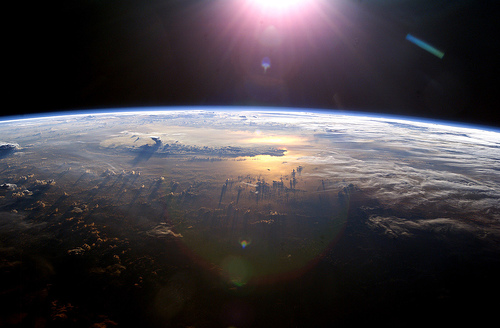Scientists accurately measure the 'edge of space'

The fuzzy point where the earth's atmosphere transitions into space has been detected by an instrument developed by scientists at the University of Calgary with "unprecedented detail".
According to the team, space begins 118 km (73.3 miles) above Earth, which confirms what other scientists consider the boundary or edge of space. It's a mere 10 miles off the Kármán line (100 km), which has been commonly regarded as the boundary between atmosphere and outer space.
Science Daily reports that the instrument – called the Supra-Thermal Ion Imager – was carried by a NASA rocket, JOULE-II, on Jan. 19, 2007, and traveled to an altitude of about 200 kilometers above sea level and collected data for the five minutes it was moving through the "edge of space."
There's no such thing as a precise end to the Earth's atmosphere since it just progressively gets thinner as you go up. So let's take a look at how the instrument was able to make such a measurement.
David Knudsen, associate professor in the Department of Physics and Astronomy at U of C and head of the Space Physics Division of the Institute for Space Imaging Sciences (ISIS), explains; "When you drag a heavy object over a surface, the interface becomes hot. In JOULE-II we were able to measure directly two regions being dragged past each other, one being the ionosphere -- being driven by flows in space -- and the other the earth's atmosphere."
"It's only the second time that direct measurements of charged particle flows have been made in this region, and the first time all the ingredients – such as the upper atmospheric winds – have been included," said Knudsen.
Until now, the major space powers simply defined the point at which the earth stops and space begins as the lowest perigee attained by orbiting space vehicles. The accuracy achieved by the the scientists opens the door to further insight:
The results have given us a closer look at space, which is a benefit to pure research in space science. But it also allows us to calculate energy flows into the Earth's atmosphere that ultimately may be able to help us understand the interaction between space and our environment. That could mean a greater understanding of the link between sunspots and the warming and cooling of the Earth's climate as well as how space weather impacts satellites, communications, navigation, and power systems.
The results were published this week in a paper by Knudsen and his colleagues in the Journal of Geophysical Research.
As for the price-tag, the Canadian Space Agency invested $422,000 in the development of the Supra-Thermal Ion Imager instrument on JOULE-II.
